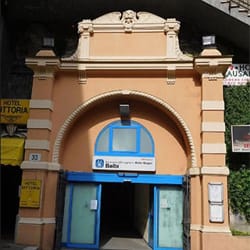The Liguria region is indeed still today a land of fishermen and sailors but through time it has been a starting point of many expeditions.
The Galata Museum of the Sea in the city’s harbor is a must visit to learn about the city’s past.
It is located in a metal and glass building which was designed by the worldwide famous Italian architect Renzo Piano.
The museum has 23 large rooms with both permanent and temporary exhibitions, it is arranged on four floors and on the last one there is a panoramic terrace called Mirador from which one can see a 360 degree view of the entire city of Genoa and its port.

Right in front of the museum (and part of it) is the Nazario Sauro, the largest Italian submarine ever built and visitors can try it out and learn about its use by the military. Getting aboard the Nazario Sauro is a unique experience for the whole family. You have the opportunity to understand life under the sea thanks to the interaction and the games organized to make learning easier and more enjoyable. You can, for example, dive and climb up on top of the submarine, use the periscope and discover its secrets in a fun way.
The Galata Museum, known to be the largest maritime museum in the Mediterranean region, offers a modern and pleasing building on the outside and its collections have the ability to engage visitors with interactive displays so adults and children alike can understand the main concepts in a playful and entertaining way.
The Galata museum aims to revive the epic Italians discoveries in the new lands in the past centuries.
The visit begins on the ground floor just in front of a large fresco by Cristoforo de Grassi which depicts the port of Genoa as it used to be during the 17th century.
Back then Genoa played a key role in the maritime world due to its strategic position on the Mediterranean Sea.
Within this museum, among reconstructed galleys, precious nautical charts, atlases, globes, ship models and ancient weapons, you can take a journey through the history of the sea and navigate through the most famous discoveries by Ligurian seafarers.

Most people around the world erroneously think that Christopher Columbus was Spanish but truth is the famous explorer was born in Genoa and his name at birth was Cristoforo Colombo.
The museum tells his story and that of many other Ligurian seafarers who have explored the Seven Seas.
Amongst the many important documents included in the Cristoforo Colombo section of the Galata Museum are two signed scripts that doubtless certify the birth of the great explorer in our city and his code of privileges, the latter is a book with all the awards and titles given to him during the years he worked at the service of the Spanish monarchy.

On the second floor of the museum there are paintings, maps, hydrographs, atlases and many maritime instruments. There is also a rescue boat and a reconstructed captain’s room on an old galley.
There is also an exhibition about shipwrecks and a small cinema where they play a video with a reconstruction of a shipwreck in 4D which means sound, movement and water sprays!
In the museum there is also a section dedicated to migrants and migrations. This topic is very current given the large number of immigrants who have been reaching the coasts of Italy in the past years and this section of the museum reminds us that Italians were migrant themselves at the beginning of the 20th century.
Suddenly you hear the puffs of the ferryboats as you are shown images from great films and novels about the belle époque: you are in fact in the era of steamboats and, through a suggestive reconstruction of a transatlantic ship similar to the famous ‘Titanic,’ you learn about how Italians migrated to Argentina and America at the beginning of the 1900 and during World War I. This section is certainly the most emotional one of the entire tour because you can understand how many families had to split up to look for a better life elsewhere.

The museum also organizes special courses to pass on Genoese maritime traditions. These courses, both for children and adults, vary from teaching how to sail to surviving at sea and there are also many workshops about fishing techniques, maritime knots, marine biology and also about environmental conservation.






























































